Why You’ll Love This Recipe
This easy homemade focaccia bread combines minimal effort with maximum flavor! With a soft, chewy texture, crisp edges, and the richness of olive oil, it’s perfect for:
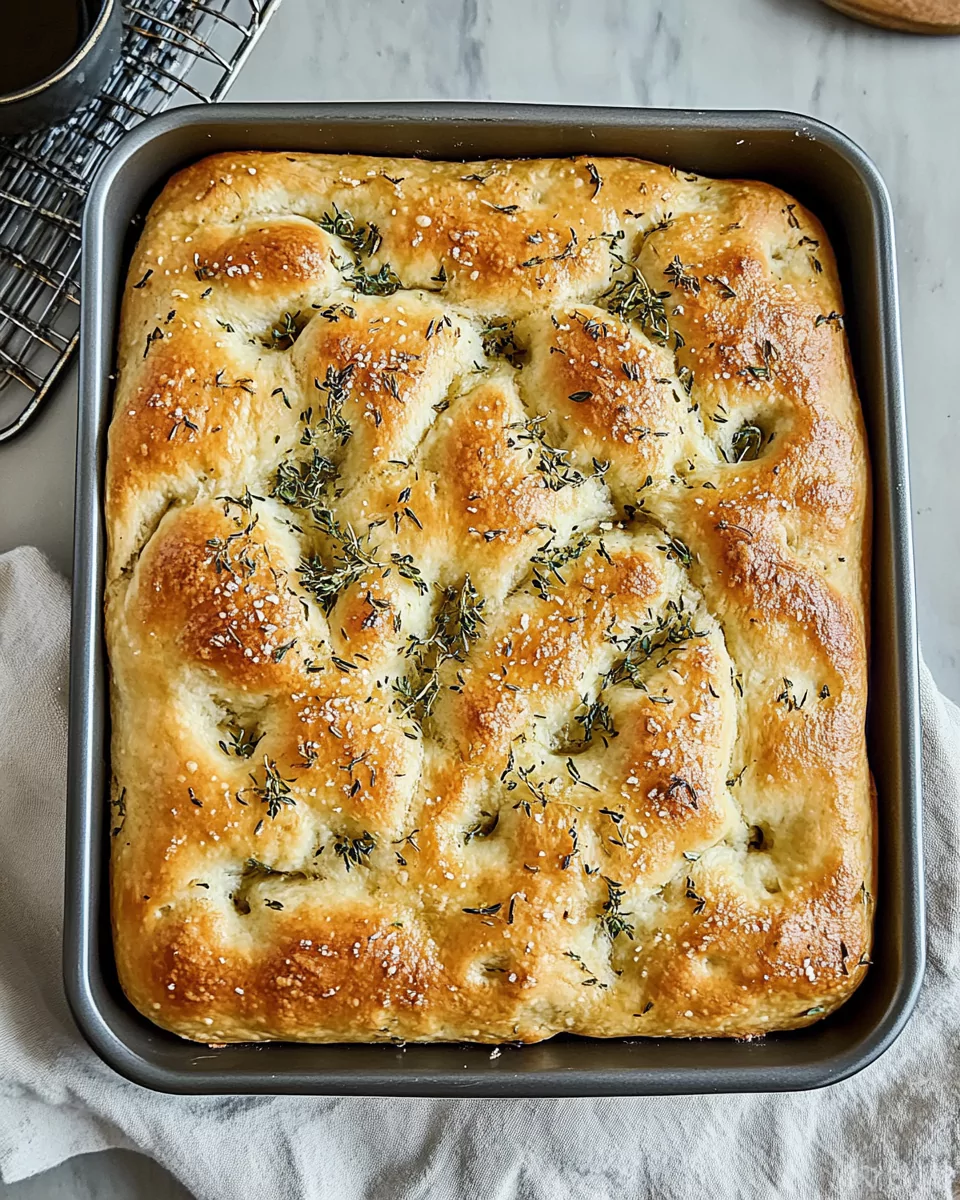
- Breakfast or brunch.
- Toasted sandwiches and paninis.
- A quick snack or side dish.
This recipe uses only a handful of ingredients and relies on a slow, cold fermentation process to develop its signature flavor. Whether you’re a beginner or an experienced baker, this focaccia bread will wow your taste buds and your guests.
Preparation Phase and Tools to Use
Essential Tools and Equipment
- Large Mixing Bowl: For mixing and allowing the dough to rise.
- Wooden Spoon: To combine the dough ingredients.
- Plastic Wrap: For covering the bowl during refrigeration.
- 9×13-inch Baking Pan: Ensures the perfect thickness for focaccia.
- Non-Stick Spray: To prevent sticking and create a smooth release.
- Wire Cooling Rack: Prevents the bottom of the bread from becoming soggy after baking.
- Kitchen Scale (Optional): Guarantees precise measurements.
Why These Tools Matter
- The baking pan size ensures even cooking and the characteristic focaccia height.
- Proper coverage (plastic wrap) prevents the dough from drying out during its long rise.
- A cooling rack helps maintain the bread’s texture, ensuring it stays crisp and airy.
Preparation Tips
- Measure Accurately: Use a scale for consistent results, especially for flour and water.
- Use Lukewarm Water: This helps activate the yeast without killing it.
- Opt for Quality Ingredients: A high-quality extra-virgin olive oil makes all the difference.
Ingredients
For the Dough
- 500 g (4 cups, spoon and leveled) bread flour
- 7 g (2 1/4 teaspoons or 1 packet) instant yeast
- 2 teaspoons kosher salt
- 480 g (2 cups) lukewarm water
For Flavor and Topping
- 6 tablespoons high-quality extra-virgin olive oil, divided
- Flaky salt, for finishing
- 1 tablespoon chopped rosemary (optional)
Step-by-Step Directions
1. Mix the Dough
- In a large mixing bowl, combine bread flour.
- Add the yeast and kosher salt on opposite sides of the bowl to prevent direct contact.
- Mix the dry ingredients using your fingers, creating a well in the center.
- Pour in lukewarm water and stir with a wooden spoon until a shaggy dough forms.
2. Oil the Dough
- Drizzle 2 tablespoons of olive oil over the dough.
- Rub the oil gently across the dough surface with your fingers.
- Wiggle the dough from the bowl’s edges, coating the sides and bottom with oil.
- Cover the bowl tightly with plastic wrap and refrigerate for at least 18 hours (or up to 72 hours for enhanced flavor).
3. Prepare the Baking Pan
- Spray a 9×13-inch baking pan with non-stick spray.
- Drizzle 2 tablespoons of olive oil in the center and set aside.
4. Shape the Dough
- Remove the dough from the fridge.
- Fold the edges toward the center, rotating the bowl to form a smooth ball.
- Place the dough in the prepared baking pan, turning it to coat fully in olive oil.
- Allow the dough to rise uncovered in a warm, draft-free place for 3–4 hours, until it nearly fills the pan.
5. Preheat the Oven
- Preheat your oven to 425°F (218°C) towards the end of the second rise.
6. Create Dimples and Add Toppings
- Drizzle the remaining 2 tablespoons of olive oil over the risen dough.
- Rub the oil across the dough surface evenly.
- Sprinkle with flaky salt and optional chopped rosemary.
- Use your fingers to press straight down into the dough, creating deep dimples. Gently stretch the dough to fill the pan’s corners if needed.
7. Bake the Bread
- Bake in the preheated oven for 25–30 minutes, or until golden brown and pulling away from the pan edges.
- Let the focaccia cool in the pan for 5 minutes.
- Use a large metal spatula to transfer the bread to a wire rack and cool for an additional 10 minutes before slicing.
Serving Suggestions
Homemade focaccia bread is incredibly versatile. Here are some creative ways to serve it:
1. As a Standalone Snack
- Enjoy it warm with a drizzle of olive oil or balsamic vinegar.
- Sprinkle extra herbs like rosemary or thyme for an aromatic bite.
2. Breakfast Options
- Pair with scrambled eggs or avocado slices.
- Make breakfast sandwiches with egg, cheese, and your favorite fillings.
3. For Lunch or Dinner
- Use as a base for toasted paninis or gourmet sandwiches.
- Serve alongside soups, such as tomato bisque or minestrone.
4. Party-Ready Appetizer
- Cut into small squares and serve with a trio of dipping oils.
- Top with fresh mozzarella, basil, and tomatoes for a bruschetta-style twist.
Side Dish Recommendations
Pair your focaccia bread with these mouthwatering sides to create a complete meal:
- Classic Caesar Salad
Crisp romaine, tangy dressing, and crunchy croutons complement the bread’s richness. - Roasted Tomato Soup
The soft, chewy bread is perfect for dunking into a creamy, tangy soup. - Caprese Salad
Combine fresh mozzarella, tomatoes, and basil for a simple, refreshing pairing. - Garlic Herb Butter Shrimp
Serve the bread as a side to soak up the flavorful butter sauce. - Charcuterie Board
Include focaccia as part of a spread with cheeses, cured meats, and pickles. - Mediterranean Chickpea Salad
Pair with a light, protein-packed salad featuring cucumbers, olives, and feta. - Pasta Dishes
Serve focaccia alongside spaghetti Bolognese, fettuccine Alfredo, or carbonara. - Grilled Vegetables
Roast zucchini, eggplant, and bell peppers for a healthy, flavorful side.
Common Mistakes to Avoid
1. Skipping the Long Rise
- Why it Matters: Cold fermentation develops flavor and improves texture.
- How to Fix: Plan ahead and let the dough rest for at least 18 hours.
2. Using the Wrong Pan Size
- Why it Matters: Too small a pan can make the bread too thick, while a large pan spreads it too thin.
- How to Fix: Stick to the recommended 9×13-inch pan.
3. Forgetting to Oil the Pan
- Why it Matters: Ensures a crispy bottom and prevents sticking.
- How to Fix: Generously oil the pan before placing the dough.
4. Underproofing the Dough
- Why it Matters: Proper rising ensures an airy and soft texture.
- How to Fix: Allow the dough to rise until it nearly fills the pan (3–4 hours).
5. Overbaking
- Why it Matters: Results in a dry and hard crust.
- How to Fix: Bake only until the bread is golden brown and slightly pulling away from the edges.
6. Ignoring Dimples
- Why it Matters: The dimples trap olive oil and toppings, enhancing flavor.
- How to Fix: Press firmly into the dough with your fingertips before baking.
How to Perfect the Recipe
1. Experiment with Toppings
- Add caramelized onions, olives, or sun-dried tomatoes for extra flavor.
- Sprinkle grated Parmesan or Pecorino Romano before baking for a cheesy finish.
2. Adjust the Texture
- For extra softness, use a blend of bread flour and all-purpose flour.
- For a crispier crust, bake at a slightly higher temperature for a few minutes.
3. Customize the Flavor
- Infuse olive oil with garlic, rosemary, or chili flakes before drizzling.
- Use flavored salts like smoked or herbed varieties for a unique touch.
Recipe Tips
1. Achieving the Perfect Texture
- For a Chewy Crust: Let the dough ferment for the full 72 hours.
- For Extra Airiness: Be gentle while shaping the dough to avoid deflating it.
2. Flavor Enhancements
- Drizzle infused olive oil (garlic or herb-infused) for a deeper flavor profile.
- Sprinkle seeds like sesame, fennel, or poppy on top before baking.
3. Baking Tips
- Always preheat the oven fully to ensure even cooking.
- Rotate the pan halfway through baking to avoid uneven browning.
Storage and Reheating Instructions
1. Storing Leftovers
- Room Temperature: Store in an airtight container for up to 2 days.
- Refrigerator: Wrap tightly in plastic wrap and keep for up to 5 days.
2. Freezing Focaccia
- Slice into portions and wrap each piece in foil or plastic wrap.
- Place the wrapped slices in a freezer-safe bag and freeze for up to 3 months.
3. Reheating Tips
- Oven: Warm at 350°F (175°C) for 5–7 minutes for a crisp crust.
- Microwave: Heat for 15–20 seconds for a softer texture.
- Toaster Oven: Toast for 3–4 minutes for a slightly crunchy edge.
FAQs
1. Can I Use All-Purpose Flour Instead of Bread Flour?
Yes, but bread flour provides better structure and chewiness due to its higher protein content.
2. What’s the Purpose of Cold Fermentation?
Cold fermentation slows yeast activity, enhancing the flavor and creating a light, airy crumb.
3. Do I Have to Use Olive Oil?
Olive oil is traditional for focaccia and adds richness. However, you can experiment with other oils like avocado or grapeseed for a different flavor.
4. Why Are My Dimples Disappearing?
This happens if the dough is overproofed. Ensure the second rise is just until the dough fills the pan.
5. Can I Add Sweet Toppings?
Absolutely! Try drizzling honey, adding fresh fruit, or sprinkling cinnamon sugar before baking.
6. How Do I Prevent Sogginess?
Cool the bread on a wire rack immediately after baking to let steam escape.
7. Can I Make This Gluten-Free?
Yes, use a high-quality gluten-free flour blend designed for bread recipes. Add xanthan gum if your blend lacks it.
8. Why Is My Focaccia Too Dense?
This could be due to underproofing, inactive yeast, or overmixing the dough. Use fresh yeast and follow the rising times carefully.
Conclusion
This easy homemade focaccia bread is a true showstopper for any meal. Its versatility, rich flavor, and simple preparation make it a must-try recipe for beginners and experienced bakers alike. Whether you’re enjoying it fresh from the oven or using leftovers for sandwiches, this focaccia will never disappoint.
Ready to elevate your bread game? Try this recipe today and savor the magic of homemade focaccia!
Easy Homemade Focaccia Bread
Ingredients
- 500 g 4 cups, spoon and leveled bread flour
- 7 g 2 1/4 teaspoons or 1 standard packet instant yeast
- 2 teaspoons kosher salt
- 480 g 2 cups lukewarm water (see notes for preparation)
- 6 tablespoons high-quality extra-virgin olive oil divided
- Flaky salt for topping
- 1 tablespoon chopped rosemary optional
Instructions
Mix the Dough:
- In a large bowl, combine the bread flour. Add the yeast and kosher salt on opposite sides of the bowl to prevent direct contact initially.
- Use your fingers to mix the dry ingredients together, then create a well in the center.
- Pour in the lukewarm water and stir with a wooden spoon until a wet, shaggy dough forms.
Oil the Dough:
- Drizzle 30 g (2 tablespoons) of olive oil over the surface of the dough. Use your fingers to rub the oil over the dough.
- Gently wiggle the dough from the edges of the bowl to coat the sides and bottom with oil.
- Cover the bowl tightly with plastic wrap and refrigerate for at least 18 hours, up to 72 hours.
Prepare the Baking Pan:
- Spray a 9×13-inch baking pan with non-stick spray and drizzle 30 g (2 tablespoons) olive oil in the center of the pan. Set aside.
Shape the Dough:
- Remove the dough from the fridge. Use your fingers to pull the edges of the dough towards the center while rotating the bowl, forming the dough into a ball.
- Transfer the dough to the prepared baking pan, turning it a few times to coat the entire surface in olive oil.
- Leave the dough uncovered to rise in a warm, draft-free place for 3-4 hours, until it nearly fills the pan.
Preheat the Oven:
- Towards the end of the second rise, preheat the oven to 425°F (218°C).
Dimples and Topping:
- Drizzle the remaining 30 g (2 tablespoons) olive oil over the dough. Rub it over the surface, then sprinkle the chopped rosemary (if using) evenly.
- Use your fingers to press straight down into the dough, creating deep dimples all over. Gently stretch the dough to fill the corners of the pan, if needed.
- Sprinkle flaky salt over the top.
Bake the Bread:
- Bake for 25-30 minutes, or until golden brown and pulling away from the sides of the pan.
- Let the focaccia cool in the pan for 5 minutes, then carefully transfer it to a wire rack (use a large metal spatula if needed) to prevent the bottom from getting soggy. Allow it to cool for 10 minutes before slicing and serving.
Notes
Storage: Store leftovers in an airtight container at room temperature. Focaccia is great for toasted paninis, breakfast sandwiches, or other sandwiches!
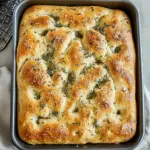
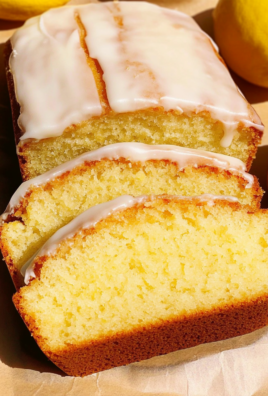
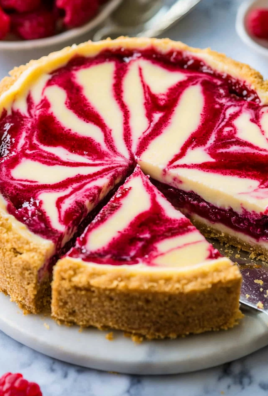
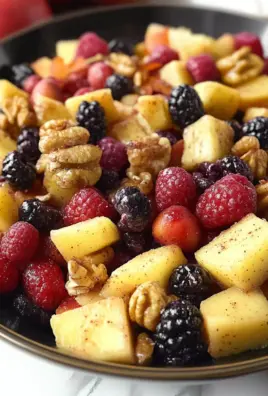
Leave a Comment